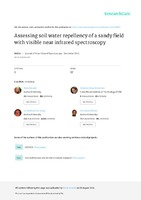Mostrar el registro sencillo del ítem
Assessing soil water repellency of a sandy field with visible near infrared spectroscopy
| dc.contributor.author | Knadel, Maria | |
| dc.contributor.author | Masís-Meléndez, Federico | |
| dc.contributor.author | Wollesen de Jonge, Lis | |
| dc.contributor.author | Moldrup, Per | |
| dc.contributor.author | Arthur, Emmanuel | |
| dc.contributor.author | Greve, Mogens Humlekrog | |
| dc.date.accessioned | 2018-04-10T16:19:10Z | |
| dc.date.available | 2018-04-10T16:19:10Z | |
| dc.date.issued | 2015 | |
| dc.identifier | https://journals.sagepub.com/doi/pdf/10.1255/jnirs.1188 | es |
| dc.identifier.citation | Knadel, M., Masís-Meléndez, F., Wollesen de Jonge, L., Moldrup, P., Arthur, E., & Humlekrog-Grevea, M. (2015). Assessing soil water repellency of a sandy field with visible near infrared spectroscopy. Journal of Near Infrared Spectroscopy, 23(3), 215-224 | es |
| dc.identifier.uri | https://hdl.handle.net/2238/9678 | |
| dc.description | Artículo | es |
| dc.description.abstract | Soil water repellency (WR) is a widespread phenomenon caused by aggregated organic matter (OM) and layers of hydrophobic organic substances coating the surface of soil particles. These substances have a very low surface free energy, reducing a soil’s water attraction. There is focus on WR due to its effects on germination, root growth, liquid–vapour dynamics, surface erosion and leaching of chemicals through fingered flow paths. However, common techniques for measuring WR are time-consuming and expensive. Meanwhile, it is well established that visible near infrared (vis-NIR) spectroscopy is a reliable method for determining soil OM. Potentially it could therefore provide fast measurements of WR through autocorrelation with OM. The aim of this study was to test the feasibility of vis-NIR spectroscopy for estimating the WR of soils with a small gradient in soil organic carbon (SOC) and texture, and to evaluate the effect of soil pretreatment on the predictive ability of WR models. A total of 87 soil samples from an agricultural coarse sandy field in Denmark were analysed for SOC, particle size fractions, water content and WR. Soil samples were scanned with a vis-NIR sensor (350–2500 nm) after air- and oven-drying at 60°C and 105°C. WR, expressed as liquid surface tension (mN m−1), was determined using the molarity of ethanol droplet test. Partial least squares regression models of SOC, texture and water content showed no predictive ability (r2 values between 0.10 and 0.51). However, successful models (r2 = 0.85) were generated for WR. The majority of bands important in the vis-NIR region of WR models were related to different components of OM indicating that, across the investigated field, WR was related to specific hydrophobic components of soil OM rather than to the total amount of carbon. A lower prediction error of the WR model for soils dried at 105°C (1.93 mN m−1) than at 60°C (2.52 mN m−1) can be explained by a lower range of WR values for the soils dried at 105°C. Moreover, a higher temperature reduced the number of absorption bands related to OM, indicating a degradation of hydrocarbon groups and a more hydrophobic character of the soil. | es |
| dc.language.iso | eng | es |
| dc.publisher | Scopus | es |
| dc.relation.hasversion | 10.1255/jnirs.1188 | es |
| dc.rights | acceso abierto | es |
| dc.source | Journal of Near Infrared Spectroscopy | es |
| dc.subject | Espectroscopia | es |
| dc.subject | vis-NIR | es |
| dc.subject | PLSR | es |
| dc.subject | Tensión | es |
| dc.subject | Research Subject Categories::FORESTRY, AGRICULTURAL SCIENCES and LANDSCAPE PLANNING | es |
| dc.subject | Research Subject Categories::NATURAL SCIENCES::Chemistry::Analytical chemistry::Spectroscopy | es |
| dc.title | Assessing soil water repellency of a sandy field with visible near infrared spectroscopy | es |
| dc.type | artículo original | es |
Ficheros en el ítem
Este ítem aparece en la(s) siguiente(s) colección(ones)
-
Artículos [12]


